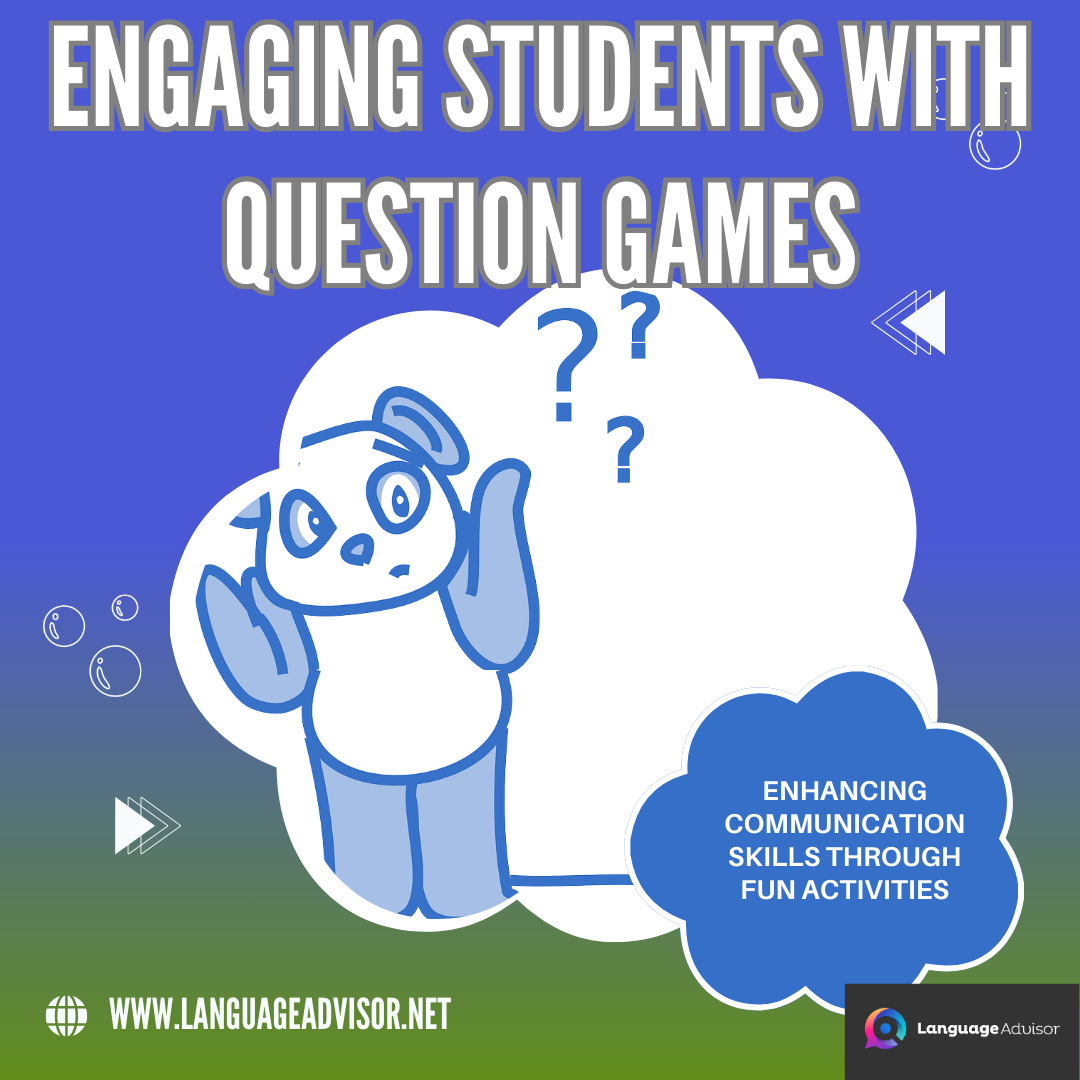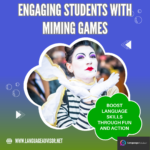Engaging Students with Question Games: Enhancing Communication Skills through Fun Activities
Engaging Students with Question Games

Asking and answering questions is a fundamental part of mastering any language, and for ESL students, developing these skills is crucial for effective communication. Traditional methods of teaching questions can sometimes be monotonous, but incorporating question games into your lessons can transform the learning experience. These games encourage students to practice forming and responding to questions in a dynamic and interactive environment, helping them build confidence and fluency. In this blog post, we will explore a variety of question games that can make learning fun and impactful for ESL students.
Engaging Students with Question Games

Balloon Stamp
This amusing ESL miming game can be played by students of all ages and levels. Before you play, have a list of vocabulary items ready.

- Age/Level: Young learners
- Time: 15 minutes
- Players: Individual
- Preparation: Balloons, rubber bands, and questions on slips of paper
- Aim: To ask and answer questions
Procedure
Give each student a balloon with a question inside.
The students then attach their balloon to their ankle with a rubber band.
The objective of the game is for the students to stamp on another student’s balloon. When a balloon is popped, everyone stops. The student, who popped the balloon, asks the question to the student who had their balloon popped.
If the student answers the question correctly, he/she can continue trying to pop other balloons. If not, the student is out of the game and has to sit down.
Then, the game continues.
The winner is the last remaining student with a balloon.
You could play this game without putting the question slips in the balloons. In this case, you would ask the questions to the students.

Dartboard Game
Play this simple Q & A game with your students. It works well with students of all ages and levels.

- Age/Level: Any
- Time: 20 minutes
- Players: 2 teams
- Preparation: A small ball or eraser
- Aim: To answer questions
Procedure
For darts, you can use an eraser or a small soft ball. You could also ask the students to make paper airplanes as darts.
Draw a target on the board with points going around it, much like a dartboard. Separate the students into two teams. Ask a question to the class. The first student to answer correctly throws a dart at the target. Wherever the dart hits, correlates with the amount of points won for that team.
Alternatively, you could have a student from each team come up and throw a dart. The student with the highest score gets to answer a question. If they are correct, they keep the points they scored.
The team with the highest number of points at the end of the game wins.

Duel
Here is a creative question and answer game to play with your students.

- Age/Level: Young learners
- Time: 10 minutes
- Players: Individual
- Preparation: A list of questions
- Aim: To answer questions
Procedure
Have the students stand in a circle.
Tell the students to form guns by clasping both their hands together.
Then call out a student’s name. The two students on either side of that student race to shoot the named student.
The slower of the two is out and has to answer a question.
When there are two students left, get them to have a duel to see who the winner is.

Fanning the Kipper
Here is an amusing ESL relay race to play with your students.

- Age/Level: Young learners
- Time: 20 minutes
- Players: Individual or pairs
- Preparation: Paper and scissors
- Aim: To answer questions
Procedure
Tell the students that they are going to play a relay race using cut out fish.
Cut out the shape of a fish from a newspaper or piece of paper, and ask the students to do the same.
Then, mark a start and finish line on the floor.
All the students line up with their kippers (the cut out fish). Ask a question to each student one by one. If a student answers correctly, they fan their kipper once using a book. This continues until the first kipper crosses the finish line and wins. Alternatively, you may have teams of two, one player at each line.
Ask a question to the players at one line. The first player to answer correctly can start fanning their kipper in a relay race.
The player fans it across the opposing line, and the other player fans it back to the start.
Keep asking questions to the players until all the players have started the relay race and see who gets back first.
Engaging Students with Question Games

Flinch
This is a fun way to revise question and answer structures.

- Age/Level: Young learners
- Time: 10 minutes
- Players: Individual
- Preparation: A ball
- Aim: To answer questions
Procedure
You will need a soft ball for this game.
Get the students to stand in a circle with their arms folded. You stand in the middle of the circle with a ball. Throw or pretend to throw the ball to a student.
If the ball is thrown, the student catches it and throws it back.
If the student doesn’t manage to catch the ball in time, they must answer a question and sit down.
If you fake a throw and the student flinches, the student answers a question and sits down. If they don’t flinch, the game continues.
The last student left is the winner.

Killer
In this ESL question and answer game, students have to ask each other target questions set by the teacher. This game is useful because you can review any question pattern or form.

- Age/Level: Any
- Time: 20 minutes
- Players: Individual
- Preparation: None
- Aim: To ask and answer questions using different grammatical structures
Procedure
Tell the students to write a question using the structure being studied.
When they have finished, ask all the students to put their heads down and close their eyes. Walk round the class and touch two students on the shoulder. They are now the ‘Killers’. Tell all the students to stand up and start asking their questions to their classmates.
Explain that the students must mark down every time they ask their question on the back of their paper.
Give the students five minutes to ask their questions to as many people as they can. During the game, the killers try to kill as many students as possible by winking at them. If a student is killed, they have to go back to their seat and sit down. When the five minutes are up, have the students raise their hands, according to how many times they asked their question.
The student who asks the most people wins.
You can play this question game several times using different grammatical structures.

Pac-man
Get your students’ attention with this fun ESL question and answer game. Before you begin, have a list of questions prepared.

- Age/Level: Young learners
- Time: 15 minutes
- Players: Individual
- Preparation: A list of questions
- Aim: To answer questions
Procedure
Start by moving the tables and chairs out of the way to create a space to play the game.
Tell the students that when you say ‘Go’, they have to run around the room, and when you say ‘Stop’, they must stop exactly where they are.
When you say ‘Stop’, ask the class a question.
The first player to put their hand up can answer the question.
If they are correct, they are allowed to take one pivoted step to try to touch other students. Each student they are able to touch is out of the game. Then shout ‘Go’, and the steps are repeated. The winner is the last student left standing.
Engaging Students with Question Games

The Waiting Game
Need an idea for something to do while you are waiting for your students to turn up? Try this enjoyable question and answer game.

- Age/Level: Any
- Time: 5 to 10 minutes
- Players: Class
- Preparation: None
- Aim: To ask and answer questions
Procedure
Write ‘You’ and ‘Me’ on the board.
‘You’ represents the students and ‘Me’ represents the teacher.
Go around the class and play rock, paper, scissors with each student. If a student wins, they score a point and must ask you a question. If you win, you get a point and must ask the student a question. After everyone has played, add up the scores.

Three Step Tag
This is a lively question and answer game.

- Age/Level: Any
- Time: 15 minutes
- Players: Individual
- Preparation: Blindfolds
- Aim: To ask and answer target questions set by the teacher
Procedure
Choose one or two students to be the ‘Catchers’ and blindfold them. All the other students find a spot in the classroom and stand still. The catchers’ task is to find the other students and touch them. The other students remain completely silent to avoid being caught. To avoid being caught, the students are also allowed to move three steps in the whole game.
When a catcher finds a student, they have to ask a target question set by the teacher. The last student left standing is the winner.

True or False
This ESL game works well with small classes and is ideal for revising question forms.

- Age/Level: Elementary and above
- Time: 20 minutes
- Players: Individual
- Preparation: None
- Aim: To ask and answer questions
Procedure
Ask the students if they are good at lying, and ask them what makes someone a good liar.
Explain that one student is going to leave the classroom. While that student is out of the room, the class has to think of three questions to ask the missing student. However, they need to be questions that no one knows the answers to.
When the class has come up with three questions, the missing student is brought back in. The student has to answer two questions truthfully and lie about one. After the three questions have been asked, everyone in the class has to say which answer they think was a lie.
The student then reveals the truth.
Each student who guessed correctly wins a point. Repeat with another student and so on. This game can be sped up by having the students come up with a list of 20 questions first.
Engaging Students with Question Games

Verbal Football
Get your students involved with this imaginative ESL question and answer game.

- Age/Level: Any
- Time: 20 minutes
- Players: 2 teams
- Preparation: A list of questions
- Aim: To answer questions
Procedure
Draw a football pitch with players on the board. Have some kind of football sticker that you can move around the pitch.
Divide the students into two teams and ask them to give their football team a name. The game starts in the centre of the football field. To score, the teams must pass the ball forwards through the players before beating the goalkeeper.
To do so, the teams must beat each other in correctly answering questions set by the teacher.
When a team answers a question correctly, the ball moves from one player to the next in the direction that the team is playing.
If the other team answers correctly, the ball goes in the other direction.
Either team can answer any question. So, if a team keeps answering correctly, they have a high chance of scoring a goal.
The number of players you draw on the pitch is up to you, the more players the harder it is to score a goal.

Question games are a powerful tool in the ESL classroom, offering students an engaging way to practice essential communication skills. By integrating these activities into your lessons, you can create a lively and supportive atmosphere that encourages active participation and enhances language proficiency. The interactive nature of question games not only makes learning enjoyable but also helps students internalize language structures more effectively. Try incorporating some of these question games into your teaching repertoire and watch your students’ confidence and conversational abilities grow.

Engaging Students with Question Games. Also check out these class games












